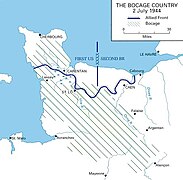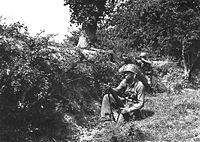Bocage

In France, bocage is a type of landscape that is characterized by a large number of hedges or wall hedges that delimit agricultural fields. The bocage occurs mainly in the French Atlantic regions of Normandy , Bretagne , Pays de la Loire and Poitou-Charentes , but also occasionally in the Massif Central and north-east France. The term bocage is also used in other Western European countries such as Belgium or Great Britain , where there are large areas of hedges. Due to its great diversity of small-scale landscape structures, the bocage today plays an important role in the preservation of biological biodiversity .
history

The hedges were created by Celtic farmers about 2000 years ago as field boundaries. During this time, the hedges became ramparts up to three meters wide, but normally about one meter wide and up to three and a half meters high. The wall hedges are overgrown with various types of shrub such as blackberry or privet bushes , so that they can be up to 4.5 meters high. Over the centuries, the farmers have planted a large part of the hedges with rows of trees, for example oak and ash , which today dominate the characteristic image of the Bocage.
The land consolidation in France and the increasing urban sprawl in the 19th and 20th centuries have increasingly degraded the Bocage. Today it has been extensively preserved, especially in areas where livestock is of great importance and where the hedges serve as a natural enclosure for the herds.
Ecological importance
Due to its variety of landscape structures, the bocage is an important habitat for the local flora and fauna . The hedges, in particular, play an important role as ecological corridors that allow animal and plant species to migrate between habitats . But also small rivers and ponds, alluvial forests , groups of trees or isolated trees and forest edges are of central importance for the biodiversity of the Bocage.
The hedges protect the often less fertile soils of the Bocage from soil erosion and provide the farmers with wood and fodder for their cattle. Because of the many ecological advantages of hedges, old hedges began to be preserved, degraded, rebuilt and new ones planted from the middle of the 20th century.
Military historical significance
The hedges of the Bocage provided good defensive positions for the German troops during the Allied invasion of Normandy . The hedgerows at a distance of 100 to 200 meters restricted the field of vision and field of fire of the Allied troops. In addition, they represented an almost insurmountable obstacle for the Allied tanks . The Wehrmacht set up anti-tank guns on the roads , so that the Allied advance was greatly slowed. In addition, the artillery fire was largely ineffective because of the vegetation, since the shrapnel got stuck in the hedges without causing damage. The only advantage of the Bocage for the Allies was that the Sherman tanks could inflict considerably greater damage on the German Tiger tanks at the shorter distances than in open terrain.
U.S. Sergeant Curtis G. Culin Jr. welded two steel sickles made of scraps of destroyed beach obstacles to the bow of a tank and used them to break through the hedgerows. General Walter M. Robertson , the commander of the US 2nd Infantry Division , reported to General Omar Bradley about Culin's device, whereupon Bradley gave orders to equip as many tanks as possible. With this device the Allies finally managed to advance with high losses. Surviving Allied soldiers reported that every single field had to be conquered through fierce fighting. They called the Bocage area "god-cursed land".
General James M. Gavin reported:
"Although they [the hedgerows] came up before Invasion Day in Britain, none of us had foreseen the difficulties they would actually cause us."
A Sherman tank with welded claws crosses a hedge
literature
- Francoise Burel & Jacques Baudry (2003): Landscape Ecology: Concepts, Methods and Applications . ISBN 1-57808-214-5 .
- Stephen Hart: The Battle of the Hedgerows: June-July 1944 . Zenith Imprint, ISBN 0-7603-1166-8 .
Movie
- Like the country, like the person. Bocage Normand. (OT: Paysages d'ici et d'ailleurs: Le bocage normand. ) Documentary, France, 2012, 26:30 min., Script and director: Jean-Michel Vennemani, moderation: Raphaël Hitier, production: System TV, arte France , Series: Wie das Land, so der Mensch , Episode 12, (OT: Paysages d'ici et d'ailleurs ), first broadcast: March 18, 2013 on arte, synopsis by ARD , online video.
Web links
- Encyclopedia Britannica ( English )
Individual evidence
- ↑ Tony Hall (Ed.): Operation "Overlord" , ISBN 3-613-02407-1 , page 119.
- ^ John Keegan : The Second World War , ISBN 0-670-82359-7 , page 573.



